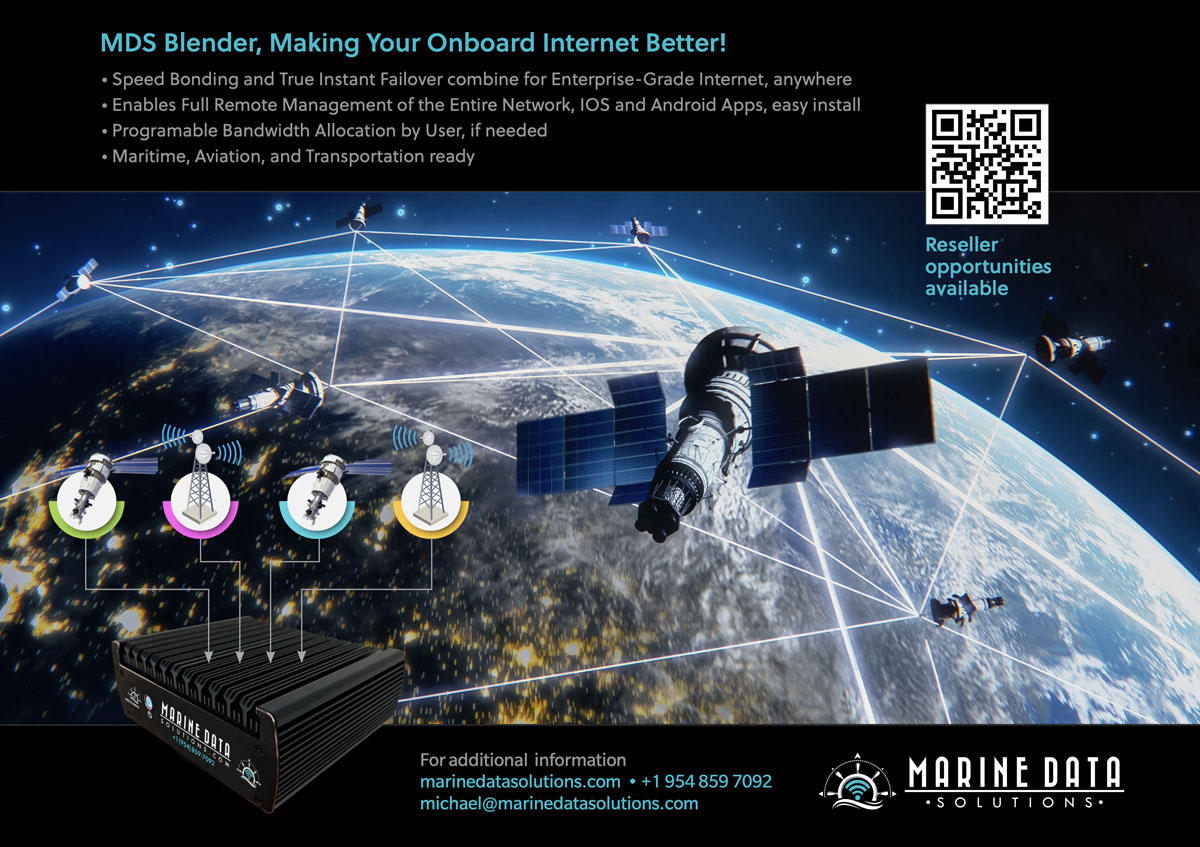Introduction: Maritime Connectivity Redefined
In the world of maritime communication, a transformative wave is sweeping across the oceans. LEO Sat, a revolutionary satellite internet service, is leading this change, signaling the decline of legacy GEO Vsat systems. This shift is far more than a mere financial adjustment; it heralds a new era of high-speed, low latency streaming and computing capabilities. Traditional GEO Vsat, which once formed the backbone of maritime connectivity, is increasingly being overshadowed by the innovative offerings of LEO Sat. This change is acutely observable, where yachts and maritime vessels are transitioning away from expensive GEO Vsat systems and satellite TV antennas.
The Evolution of Maritime Internet
LEO Sat: A Beacon of Speed and Affordability
LEO Sat’s emergence in the maritime sector has been groundbreaking. Offering high-speed, low-latency mobile internet at an affordable rate of $1 to $2 per gigabyte, LEO Sat is redefining what onboard entertainment and connectivity means. This development is particularly significant for vessels cruising in international and offshore waters, where traditional connectivity options were not only expensive but also markedly limited.
MDS Blender: Enhancing Maritime Connectivity
In this technological revolution towards LEO Sat, the MDS Blender, introduced by Marine Data Solutions, plays a pivotal role. This innovative device can speed bond multiple internet sources, achieving speeds of up to 1Gbps. It has become an essential component for ensuring consistent, enterprise-grade connectivity and is indispensable in modern maritime networking operations.
Out with the Outdated
The Gradual Decline of Legacy GEO Vsat Systems
The once-dominant legacy GEO Vsat systems are fading into obscurity, outpaced by more efficient and advanced technologies. These traditional systems, with costs ranging from $20 to $90 per gigabyte and latency figures well above 600ms, are becoming unsustainable. The hefty price tag of GEO Vsat terminals, often between $15,000 to $50,000, is increasingly difficult to justify, especially when compared to the more advanced and cost-effective LEO Sat solutions now available.
In with the Innovative
Streamlining Costs and Upgrading Experiences
The integration of LEO Sat with MDS Blender and 5G technology marks the dawn of a new era in maritime internet. This convergence leads to substantial savings in both equipment and operational costs. Adopting cutting-edge technologies like Smart TVs and Apple TVs further simplifies onboard entertainment systems. These devices make accessing streaming services more user-friendly and accessible, transforming the way entertainment is experienced on the high seas.
The Revolutionary Future of Maritime Streaming
The maritime equipment offered by LEO Sat, which is priced at only $2500 per terminal, is reshaping the industry’s approach to connectivity. The contrast between LEO Sat and the obsolete legacy systems is stark, akin to comparing a donkey cart to a Tesla. Many large vessels are now upgrading their onboard systems to multiple LEO Sat terminals, recognizing the immense financial benefits and superior performance offered by this new technology.
Making Vsat Systems Obsolete
The affordability of LEO Sat’s high-speed internet is one of its most compelling features. For maritime operations that traditionally relied on expensive GEO Vsat systems, the cost savings are significant. By switching to LEO Sat, vessels can enjoy faster internet speeds and lower latencies at a fraction of the cost. This change is particularly beneficial for vessels that operate in remote areas, where traditional satellite connectivity options are not only limited but also disproportionately expensive.
Making Satellite TV Antennas Obsolete
With the rise of LEO Sat, the need for traditional satellite TV antennas on vessels is rapidly diminishing. These antennas, once essential for receiving satellite TV signals, are becoming redundant in the face of streaming services accessible through LEO Sat’s high-speed internet. This shift is eliminating the need for costly hardware and installation, further reducing the operational costs for maritime vessels.
The Future of Maritime Connectivity
As LEO Sat continues to expand its coverage and capabilities, the maritime sector is poised for a significant overhaul in how it approaches internet connectivity. The combination of LEO Sat’s innovative technology, the versatility of the MDS Blender, and the expanding reach of 5G networks is creating a new standard in maritime communications. This trio of technologies ensures that vessels can stay connected with reliable, high-speed internet, regardless of their location.
Explore the transformative power of LEO Sat technology with Marine Data Solutions. Our comprehensive range of maritime internet solutions is designed to meet the evolving needs of modern seafaring vessels. Whether you’re a commercial operator or a leisure cruiser, our cutting-edge LEO Sat systems offer unparalleled connectivity and performance at sea.
At Marine Data Solutions, we understand the importance of staying connected, no matter where your maritime adventures take you. That’s why we’ve partnered with leading satellite providers to deliver seamless, high-speed internet access to vessels of all sizes. With LEO Sat, you can enjoy fast, reliable connectivity for streaming, communication, and navigation, ensuring a smooth and enjoyable journey on the open water.
Experience the future of maritime communication with Marine Data Solutions. Our innovative LEO Sat solutions are revolutionizing the way vessels stay connected at sea, providing unmatched speed, reliability, and coverage. Whether you’re sailing the high seas or cruising along the coast, trust Marine Data Solutions to keep you connected every step of the way.
Embracing the Future: The Role of LEO Sat in Maritime Navigation
As the maritime industry evolves, so too must its approach to navigation. LEO Sat technology is not only revolutionizing internet connectivity but also enhancing navigation systems onboard vessels. By leveraging the low-latency capabilities of LEO Sat, maritime operators can access real-time navigation data and updates, ensuring safer and more efficient journeys. This integration of connectivity and navigation represents a paradigm shift in maritime operations, where vessels are empowered with the tools they need to navigate with precision and confidence.
A Greener Future: LEO Sat and Environmental Sustainability
Beyond its technical prowess, LEO Sat also holds promise for environmental sustainability within the maritime sector. By enabling more efficient routing and navigation, vessels equipped with LEO Sat can optimize their fuel consumption and reduce emissions. Additionally, the transition away from legacy Vsat systems towards LEO Sat contributes to a smaller carbon footprint, as these systems require less energy to operate. As environmental concerns take center stage in global discourse, LEO Sat emerges as a beacon of hope for a greener, more sustainable maritime industry.
Empowering Remote Operations: The Impact of LEO Sat on Remote Monitoring
In addition to enhancing onboard connectivity, LEO Sat is also empowering remote monitoring and management of maritime operations. With real-time access to vessel data and performance metrics, operators can remotely monitor engine health, fuel efficiency, and even cargo status from anywhere in the world. This capability not only improves operational efficiency but also enables proactive maintenance and troubleshooting, reducing downtime and enhancing overall vessel performance. By bridging the gap between land and sea, LEO Sat is transforming the way maritime operations are managed and monitored.
A Seamless Experience: Integrating LEO Sat with Onboard Systems
The integration of LEO Sat with onboard systems is key to unlocking its full potential in the maritime industry. From navigation equipment to communication devices and entertainment systems, LEO Sat seamlessly connects all aspects of vessel operations, ensuring a cohesive and streamlined experience for crew and passengers alike. By centralizing connectivity through LEO Sat, vessels can reduce complexity, improve reliability, and enhance the overall onboard experience. Whether it’s accessing weather updates, streaming media, or communicating with shore-based personnel, LEO Sat delivers unparalleled connectivity at sea.
Charting a Course for the Future
As the maritime industry embraces the transformative power of LEO Sat technology, the possibilities for innovation and advancement are limitless. From enhancing safety and efficiency to reducing environmental impact and empowering remote operations, LEO Sat is reshaping the landscape of maritime navigation and connectivity. As pioneers in the field, Marine Data Solutions is proud to lead the charge towards a future where vessels are connected, efficient, and sustainable. Join us in charting a course for the future of maritime navigation with LEO Sat technology.
Unlocking New Opportunities: LEO Sat and Maritime Commerce
In addition to its impact on navigation and operations, LEO Sat technology is also opening up new opportunities for maritime commerce and trade. By providing reliable and high-speed internet connectivity, LEO Sat enables vessels to engage in real-time communication, data exchange, and transaction processing while at sea. This capability facilitates smoother logistics operations, faster decision-making, and greater efficiency in supply chain management. Moreover, LEO Sat empowers maritime businesses to explore new markets, collaborate with global partners, and expand their reach beyond traditional boundaries. As the maritime industry embraces the digital age, LEO Sat emerges as a catalyst for innovation, growth, and prosperity on the high seas.
Fostering Global Connectivity: LEO Sat and Humanitarian Aid
Beyond its commercial applications, LEO Sat technology also plays a crucial role in humanitarian efforts and disaster response operations. In times of crisis, when traditional communication infrastructure may be compromised, LEO Sat provides a lifeline for affected communities and relief organizations. By delivering high-speed internet connectivity to remote and disaster-stricken areas, LEO Sat facilitates coordination, information dissemination, and access to essential services. This capability enables timely response efforts, enhances situational awareness, and supports the delivery of critical aid and supplies to those in need. As a versatile tool for global connectivity, LEO Sat demonstrates its value not only in commerce and navigation but also in humanitarian endeavors, contributing to a more connected and resilient world.
Empowering Scientific Research: LEO Sat and Oceanographic Studies
In the realm of scientific research, LEO Sat technology is revolutionizing oceanographic studies and marine exploration. By providing uninterrupted connectivity to research vessels and oceanographic instruments, LEO Sat enables scientists to gather real-time data on ocean currents, temperature variations, and marine biodiversity. This data is instrumental in understanding climate change, ecosystem dynamics, and the impact of human activities on marine environments. With LEO Sat, researchers can conduct large-scale, collaborative studies spanning vast oceanic regions, unlocking new insights into the complexities of our oceans. By fostering global collaboration and knowledge sharing, LEO Sat accelerates scientific discovery and supports efforts to conserve and sustainably manage marine resources for future generations.
Enabling Educational Opportunities: LEO Sat and Maritime Training
In the realm of maritime education and training, LEO Sat technology opens up new possibilities for aspiring seafarers and maritime professionals. By providing reliable and high-speed internet connectivity to maritime training institutions and onboard training facilities, LEO Sat facilitates distance learning, virtual simulations, and interactive training programs. This enables students to access educational resources, participate in remote lectures, and engage in hands-on training exercises regardless of their location or sea conditions. Additionally, LEO Sat supports continuous professional development for seafarers, allowing them to stay updated on industry trends, regulations, and best practices throughout their careers. By democratizing access to maritime education and training, LEO Sat empowers individuals from diverse backgrounds to pursue careers at sea and contribute to the sustainable development of the maritime industry.
Conclusion: The Inevitable Transition
While some vessels may continue to use legacy GEO Vsat systems due to existing infrastructure, the transition to LEO Sat is becoming an increasingly obvious choice, especially when considering the cost of hardware upgrades or system failures, with the existing GEO Vsat. Although commercial vessels are still required to maintain INMARSAT and Viasat equipment for regulatory compliance, the combination of LEO Sat, 5G, and MDS Blender represents a significant advancement in maritime internet systems. This shift is not just a change; it’s a complete overhaul of maritime connectivity, signaling the dawn of a new era where advanced technology and convenience coexist seamlessly. The maritime world is on the brink of a connectivity revolution, with LEO Sat at the helm, steering towards a future where high costs and high latency are things of the past.


